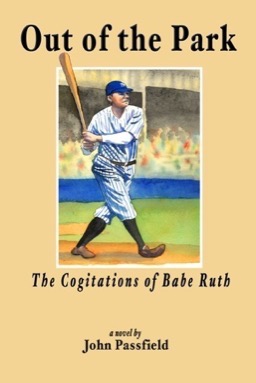Out of the Park
The Cogitations of Babe Ruth
Out of the Park
The Cogitations of Babe Ruth


Out of the Park is available at Amazon.
The Story
Babe Ruth was a baseball player who transformed the game that he played. He came into baseball in an era of what was called inside baseball, a game which employed the multiple skills of a whole team of players at almost every facet of the game in order to outscore an opposing team by a narrow margin. He transformed the game into one in which a single player could undermine all of the painstaking work of a whole team of players by hitting one pitch out of the park and sending the score higher by anywhere from one to four runs, depending on how many players were on base. In doing so, Babe Ruth came to dominate the whole sport of baseball, and to have an impact on the culture of his age.
I am attracted to the Babe story because he was a man of exceptional achievement who refashioned his field of endeavour in order to make it congenial to his particular talents. Unlike others, he rethought the basic tenets which passed for wisdom in his particular life-role and achieved the most basic understanding of his trade in order to refashion the game to suit his particular skills and his particular way of thinking. I am fascinated by the whole concept of thinking. I love to explore the interactions between the conscious and the subconscious minds, both of which I believe operate on many levels of thinking simultaneously. I cannot believe that a person of Babe Ruth’s prodigious accomplishments can have had a dull mind, and in this novel, I explore the relationship between the very surface of the mind, which is apparent to all who come into contact with such an individual, and the computer-like complexity of the subconscious mind that allows the human body to work with such extreme precision in the mind-body partnership, making decisions which must require the processing of thousands of items of relevant and irrelevant data as it arrives at each micro-second decision. It is my contention that all minds are complex, but that not all people are equally aware of the complexity of their thoughts. It has been fascinating to explore the imagery that the mind of the character, Babe Ruth, is processing at any given moment and to speculate on the amount of awareness that his conscious mind has of the various levels of thought by which he is living his life and plying his trade.
At the time at which the novel takes place, Babe Ruth is a man who has been exceptional in his field of endeavour to the point where he has re-thought the basics of his working milieu and has revised the way others approach that field of expertise. He has come to the point where there are indications that he is declining in his powers, and uses the occasion of a highly-pressured present-moment of a playoff game in Chicago in 1932 to re-examine the images of his life and life’s work in order to evaluate his accomplishment and to consider his future. His mind at whatever level chooses three present-moments in his life (1920, 1927 and 1932) – one of which he is living through as the images of the novel form (1932) – and arranges the images that he considers pertinent, in patterns that he considers to be revealing.
The text of the novel is rendered in the preconscious mode and it will be interesting for the reader to consider which of the levels of thought the main character is aware of and which levels of thought remain subconscious. Babe Ruth has been thought of, by some, as a man of little intellectual capacity; many lined up to study Albert Einstein’s brain after his death, but no one, so far as I know, suggested studying the mind of Babe Ruth as a model of eye-brain-hand coordination. Nevertheless, he must have had a mind with the complexity and the precision of a high-speed computer or he would not have been able to hit the ball with a consistency and accuracy which far surpassed that of other human beings. That he thought about more than just hitting the ball is the premise of this novel.